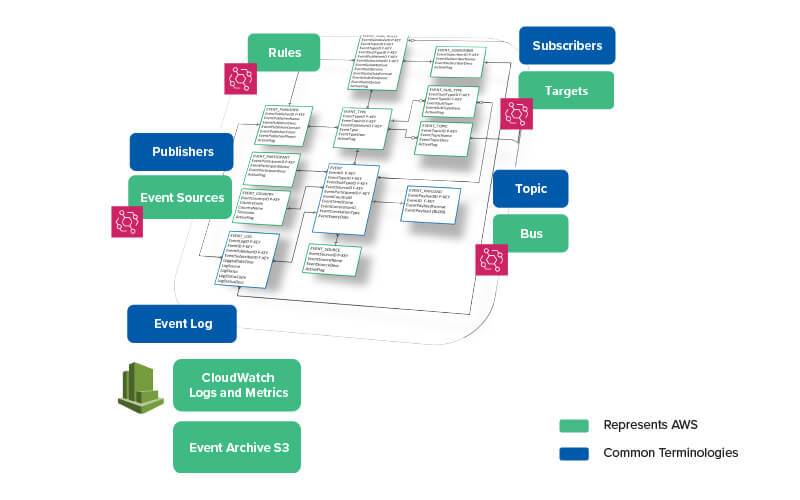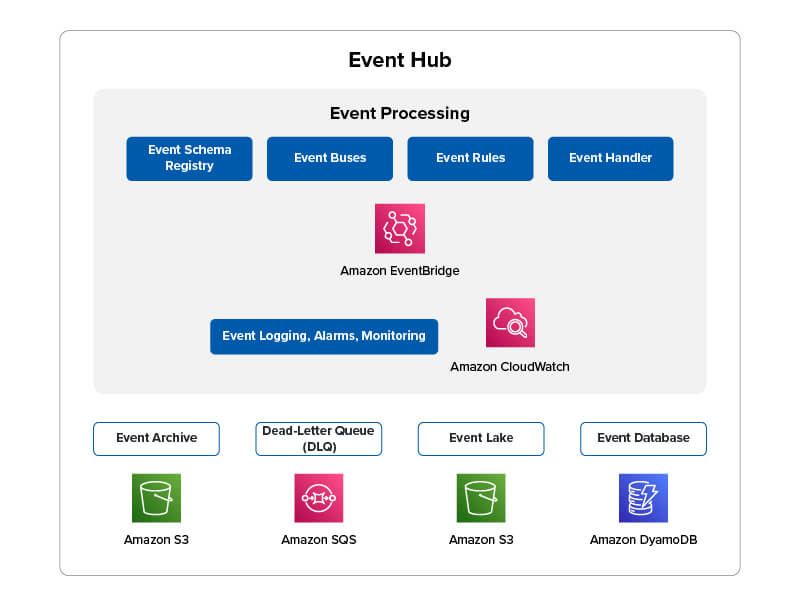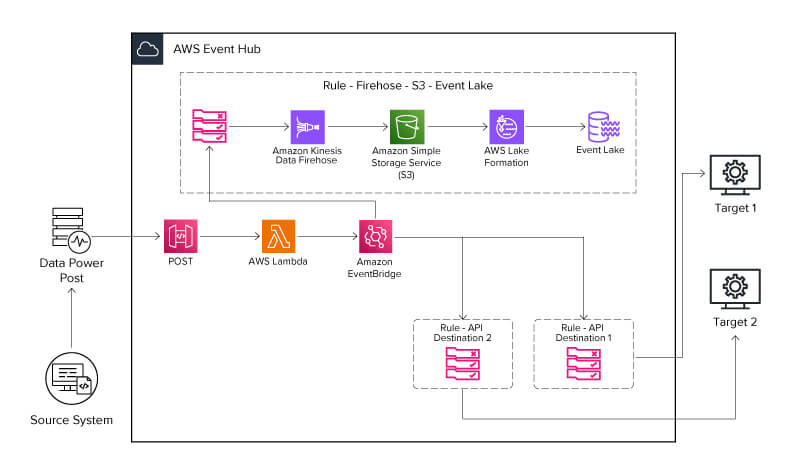This website uses cookies. By continuing to browse the site, you are agreeing to our use of cookies
Event-Driven Architecture in AWS: Amazon EventBridge – The Catalyst for Data Innovation
Data & Analytics
October 30, 2023
In today’s fast-paced digital landscape, traditional monolithic architectures have become hindrances to enterprises. As businesses expand and data volumes increase, scaling up monolithic systems becomes not only cumbersome but also cost-prohibitive. One of the major drawbacks is their susceptibility to a single point of failure. A failure in one component or module has the potential to disrupt the entire system.
The advent of microservices architecture has enabled organizations to break down monolithic systems into smaller, loosely coupled services. However, as organizations are transitioning to microservices, they encounter a new set of challenges: managing the flow of data across these loosely coupled components has become a complex puzzle to solve. This is where Event-Driven Architecture (EDA) takes center stage, acting as the linchpin that connects microservices and data and analytics.
EDA enables the real-time flow of data and events between microservices and applications. When data is generated, events are triggered, ensuring that insights are up-to-date and immediately available for decision-making. It allows organizations to create event-driven workflows that respond to changing data conditions or events in real-time.
The fusion of microservices and event-driven architecture represents a transformative leap forward. In this blog, we will explore the pivotal role that Amazon EventBridge plays in enabling event-driven architecture.
Components within an Event-driven Architecture in AWS
Core components collaborate to establish a loosely coupled and scalable system, allowing different parts of the application to communicate and respond to events without necessitating tight integration or direct dependencies:
- Event Source/Publisher: A source is a component that produces events. Examples of sources include AWS services, such as Amazon Simple Queue Service (SQS), Amazon Simple Notification Service (SNS), and Amazon Kinesis; on-premises applications; and IoT devices.
- Event Target/Subscribers: These are resources or services that receive events when triggered by event rules.
- Event Bus/Topic: The bus is a central component that receives, routes, and delivers events to different components of the application. In AWS, the bus is provided by Amazon EventBridge.
- Event Rules: Event rules define the criteria for processing events. They specify conditions that must be met for an event to trigger specific actions.
The loose coupling between event producers, event buses, and event consumers makes EDA data and analytics architectures more scalable, agile, and resilient. For instance, if an event producer becomes unavailable, the event bus can route events to other event producers. This means that EDA data and analytics architectures can continue to operate even if some components fail.

Figure 1: Terminologies in the Context of Messaging Systems
How Amazon EventBridge Facilitates Seamless Integration?
Amazon EventBridge, formerly known as CloudWatch Events, stands out as a pivotal tool for realizing the potential of event-driven architectures. It serves as a serverless event bus service that facilitates seamless integration between diverse AWS services, custom applications, and SaaS applications. EventBridge empowers the creation of real-time event processing architectures and operates on a pay-as-you-go model, ensuring cost-effectiveness by billing solely for the resources utilized.

Figure 2: Amazon EventBridge Components
Additional components as part of a typical event driven architecture include:
- Schema Registry: It serves as an efficient container for organizing schemas into logical groups. It helps validate incoming events against predefined schemas, ensuring data consistency and integrity.
- Event Handlers: Specify how event data should be processed or transformed before being sent to event targets. They can be implemented in a variety of ways, such as AWS Lambda functions, Amazon Kinesis streams, and Amazon Step Functions workflows.
- Dead-Letter Queues (DLQs): They function as targets for event rules when events cannot be successfully processed or consumed. DLQs are instrumental for debugging applications or messaging systems, as they isolate unconsumed rules, aiding in the identification of processing failures.
- Event Archive: It enhances data integrity by storing all event data in either an S3 bucket or DynamoDB, mitigating data loss during job runs, and retaining event data for auditing, compliance, and long-term storage requirements.
AWS CloudWatch Logs and Metrics can be used to monitor and troubleshoot Amazon EventBridge applications. CloudWatch Logs provides detailed logs of all events that are processed by Amazon EventBridge. CloudWatch Metrics provides metrics on the performance of Amazon EventBridge, such as the number of events processed, the number of events delivered, and the average delivery time.
Business Use Case
Our client, a leading appliance insurance provider, faced the complex task of managing data from multiple sources, including their on-premises IBM DB2 databases. Data was scattered, creating silos that hindered data accessibility and analysis.
To address this challenge, the client sought to assess their existing data landscape and consolidate it into a centralized cloud-based repository on Amazon S3, for improved efficiency and insights.
The data streams from Contract, Claim, Repair, and Product Replacement sources needed to flow seamlessly to the AWS S3 Enterprise Data Lake in real/ near-real time.
Their objective was clear: break down the data silos and create a unified data ecosystem on the AWS cloud that could drive business intelligence and decision-making.
Amazon EventBridge: Building the Event-Driven Architecture
In the pursuit of this transformation, Hexaware recommended the adoption of Amazon EventBridge, a powerful service designed to enable an event-driven architecture. The first step was to establish a seamless flow of event-based data from the client’s on-premises systems to the cloud.
Solution
The journey commenced with the ingestion of event data from on-premises systems. This data encompassed critical information such as policy data, terms, customer details, claims, product replacements, and repair records.

Figure 3: Event-Driven Architecture Diagram
When data was updated within the Scheme system, Amazon API Gateway came into play, capturing the updated data in the form of JSON files. Subsequently, Amazon Lambda was triggered, and its role was to push this captured data to Amazon EventBridge.
Amazon EventBridge served as the central hub, or “event bus,” where all incoming events congregated. EventBridge, with its robust rule-based engine, was programmed to discern the different event types and orchestrate their movement using Amazon Kinesis. This move ensured that the data flowed seamlessly to the Enterprise Data Lake (AWS S3).
A robust data lake was established within the AWS cloud, capable of accommodating vast volumes of both structured and unstructured data. The AWS Glue Data Catalog and its crawler capabilities played a pivotal role in automating data discovery, cataloging, and processing.
Business Benefits
With their data now consolidated and easily accessible, our client witnessed a transformative shift in their data capabilities. They could now harness the power of their data in near-real time to make informed business decisions, gain deeper insights into customer behavior, and streamline their operations.
Automation significantly accelerated data processing, reducing manual intervention and speeding up the entire data flow by 60%.
Amazon EventBridge, in tandem with AWS services, transformed data management for our client. By breaking down data silos, automating data flows, and enabling real-time processing, the client reaped significant technical and business benefits. The implementation not only improved operational efficiency but also empowered data-driven decision-making, laying the foundation for future growth and innovation.
Conclusion
In summary, Amazon Web Services (AWS) provides robust support for the integration of Event-Driven Architecture (EDA) into Microservices through Amazon EventBridge. This combination enables organizations to create agile, scalable, and responsive systems by leveraging loosely coupled microservices that communicate via events.
At Hexaware, we understand the paramount importance of staying ahead in the data and analytics landscape. Our team of experts is dedicated to helping organizations assess their existing data landscapes, identify opportunities for implementing event-driven architecture with Amazon EventBridge, and executing seamless solutions.
For a comprehensive understanding of how Hexaware can enhance your business using Amazon EventBridge, please reach out to us at marketing@hexaware.com. We’ll be delighted to provide you with detailed information.
About the Author

Srinivas Ganivada
Read more
Related Blogs

Enterprise Data Services: The Backbone of Modern Businesses
- Data & Analytics

Navigating Databricks’ Delta Lake Features and Type Widening
- Data & Analytics

Top 13 Data Science Services Providers: Bridging the Gap Between Data Capabilities and AI Strategy
- Data & Analytics

The Role of AI in Automating SAS to PySpark Conversion and Accelerating Data Migration
- Data & Analytics

How to Achieve New Standards in Data Quality and Observability using Databricks Lakehouse Monitoring
- Data & Analytics

Retrieval-Augmented Generation (RAG) on Amazon Bedrock
- Data & Analytics

Databricks Unity Catalog for Comprehensive Data Governance
- Data & Analytics

Ready to Pursue Opportunity?
Every outcome starts with a conversation










